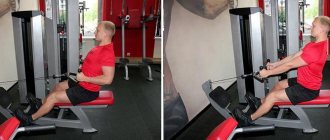Recently, debates about the importance of jogging for health have not subsided: some believe that such physical activity has become obsolete and brings nothing but pain in the joints, others, on the contrary, are sure that only with their help can you burn extra calories and lose pounds. While the parties continue to conflict, trying to find the truth, you can choose a more relevant and modern version of cardio training called interval running - what is it and what problems does it solve, read on.
For weight loss
Interval training is usually understood as those that include alternating periods of sports activities and rest. At first glance, such exercises may seem quite simple, but in reality they quickly bring noticeable results and allow you to achieve tangible progress.
According to a series of studies, interval activity is one of the most effective ways to burn fat. In terms of effectiveness, it surpasses even cardio exercises that are so popular today.
In 2009, scientists from the Canadian McMaster University, Jonathan Little and Martin Gibala, carried out a comprehensive research project designed to evaluate the effectiveness of the training. Over the course of two weeks, the researchers analyzed the results of cycling exercises consisting of several short bouts. It was assumed that a person should first work hard, and then take a breath and rest. The time of exhausting stress and relaxation was the same - thirty seconds each.
The conclusions drawn from the study were stunning. It turned out that an hour and a half bike ride is equivalent to five minutes of intensive work using innovative technology.
Why is it needed?
Interval running training has a number of undeniable advantages over classical interval running:
- By developing endurance, they help you learn to run long distances and increase speed.
- Systematic alternation of relaxation and activity modes promotes rapid and uniform burning of calories as energy consumption increases.
- The unusual type of training task does not injure muscles and helps avoid thinning of bone and joint tissues (problems that professional runners often suffer from).
In addition, jogging is a way to lose weight without losing muscle mass. Accelerating metabolism, it launches weight loss processes and allows you to quickly get into the desired shape.
Ragged run
Ragged running - alternating a moderate pace with a sharp increase in speed. After acceleration there is a transition to the tempo level before acceleration. The use of jerky running allows you to develop the cardiovascular and respiratory systems, as well as train endurance. Subsequently, it allows you to bring your heart rate back to normal in a short period of time and recover much faster.
A famous athlete who used the tactics of jerky running, Gordon Pirie, is the holder of 5 world records. He won competitions by wearing down his opponents in the first meters of the distance. Setting a high pace from the start, he forced his competitors to go in pursuit. After 200-400 meters of the distance, he switched to a moderate pace and after a short time accelerated again. This style of running continued throughout the entire distance and the competitors eventually gave up, letting Gordon Pirie take the lead.
Using jerky running at medium distances is difficult and not everyone can do it. In addition, the constant use of such tactics leads to wear and tear of the heart muscle. This type of running is one of the most difficult types to train and use. In Peary's case, he trained jerk running every training session.
For amateurs and those who want to try jerky running, I recommend using the following tactics: average pace of 500 meters, acceleration of 30-50 meters, repetition. Try to run 2000 meters using the proposed tactics and evaluate the degree of difficulty.
Who is it suitable for?
The key principle of jogging is to alternate between activity and calm modes. Although this approach is effective, beginners should not attempt it without prior preparation. If you switch to such activities earlier than six months of regular cardio exercises, you can provoke serious problems with the heart and blood vessels.
For those who are just starting to practice the “torn” technology, the standard lesson time should not exceed 30-40 minutes, of which only 20-25 are at the stage of grueling actions. You can increase the distances you run and the number of approaches only after a couple of months.
Memo
- An unusual acceleration technique is a good stress for the muscles and body. After jogging, muscles intensively spend calories to restore fibers, and metabolism accelerates.
- Interval running burns more calories. During explosive intense accelerations, energy consumption almost doubles, and even during the rest phase it remains maximum for some time.
- Each run also has a cleansing benefit: it removes toxins through sweat and harmful substances from the lungs.
- Mobile applications make life easier for runners: they calculate the required speed and distance individually to suit your requirements, tell you when to change the pace and what part of the workout has already been completed.
- Experts recommend not exceeding the permitted number of workouts during fat-burning exercises and monitoring the body’s condition to prevent exhaustion.
Do you exercise regularly, but still find yourself with a few extra pounds? Want to know what's the reason? How to exercise for fun and not think about the calories you eat.
Enter your email and click the download button ↓
Interval running: training program for weight loss
Jogging, which helps break down fat, ensures quick and healthy shedding of extra pounds without harm to your health. Since a constant alternation of types of sports activities is expected, it is recommended to practice at the stadium - it’s easier to time the intervals.
Although such a sprint requires considerable energy expenditure, obvious progress can only be achieved if tasks are systematized and carried out consistently. In other words, you need well-designed weight loss plans, which can be divided into two categories: for experienced athletes and beginners.
The main differences between the programs are reflected in the table below.
| Activity pattern/heart rate | For beginners | For experienced |
| Fast cut | 400m/130-150 | 800m/140-160 |
| Jog | 400m/100-120 | 600m/110-130 |
How is interval running different from regular running?
Interval running involves alternating between fast and slow running or walking to restore your heart rate. For example, run 400 meters quickly, and the next 400 meters - jog or go to a fast walk. Normal running is smooth and measured, without any acceleration, at the same set pace.
Photo: istockphoto.com
There are three types of interval running.
Interval sprint.
This is a short distance running alternating as fast as possible with jogging. It allows you to develop speed endurance.
Repeated run.
Run the key segment at maximum speed, then rest to restore your heart rate. After that, repeat the segment. There should be several of them during training. This type of running allows you to achieve maximum oxygen consumption.
Tempo run.
This is a run with training segments increasing speed at each subsequent one. It is especially effective for weight loss.
We work for quality: how to improve running technique
Key principles
The start begins after a classic warm-up - running at a convenient and comfortable pace for about 10-15 minutes. Next, the alternation of intervals begins, which can be calculated using two methods:
- by duration;
- by distance.
The first one is suitable for those who are used to running with a watch and have no idea about the mileage of the route. The training organization algorithm is presented in the table below.
| Duration in minutes | Nature of the exercise |
| 15 | Warm-up |
| 1+1 | Acceleration, then rest |
| 2+2 | — |
| 3+3 | — |
| 2+2 | — |
| 1+1 | — |
| 5 | Restoring breathing, finishing the workout |
The algorithm for distance exercises is built in the same way, but the meters traveled are taken as the reference system.
Interval training techniques for runners
Fartlek
Training scheme: 15 seconds maximum acceleration - 1 minute easy jogging - 1 minute running at an average pace - 2 minutes easy jogging. Repeating this cycle, you should run for 10–45 minutes without pause, depending on your fitness level.
MPC intervals
You need to choose a comfortable distance in advance in the range of 800–1,600 m. This distance must be run at a competitive pace for races of 3–5 km, strictly adhering to it and not allowing acceleration or deceleration. This is followed by a period of rest equal to the time it takes to complete the distance. The exercise is repeated several times depending on the length of the segment: for 800 m - 6-10 approaches, for 1,200 m - 4-5, for 1,600 - 3-5.
Cruising intervals
The technique is similar to the previous one, but the pace should be chosen for a long distance, for example 10 km. The periods of rest in this case are reduced to 1 minute. The total distance must not exceed 8% of the weekly mileage. The frequency of training is 1 time per week.
Replays
The segment of 200–600 m should be run at maximum pace, then approximately the same distance should be walked or jogged until complete recovery. The cycle is repeated 8–12 times.
Running uphill
For training, you need to choose a hill with a moderate slope (5-15 degrees). You need to run to the top in short segments of 60–100 m at maximum pace, alternating them with a minute of jogging or walking. You need to choose 4-10 approaches depending on your physical fitness.
Since different training techniques affect different indicators, it is most effective to select several and practice them in turn. However, you should remember the recommendations and safety precautions for beginners:
- the total number of interval training sessions for an amateur runner who trains no more than once a day in a weekly microcycle should not exceed two;
- the day before performing interval training, it is advisable to do a light warm-up jog, after which do joint exercises. The next day after intervals, run a recovery workout and do gentle stretching.
The basic rule is that for every interval workout in your training plan, there should be two low-intensity runs. This will help you get in shape safely and effectively.
Medium distance techniques: 800–1500 meters, 2–3 kilometers
Running distances depend on preliminary preparation and endurance. It is quite obvious that for a person far from the sports world, it will be difficult to cover a distance of a couple of kilometers in an accelerated mode. Beginners are advised to choose simple routes 800-1500 meters long without steep descents and ascents.
Algorithm for an inexperienced runner:
- The first stage is a warm-up warm-up. Is 800 meters or ten minutes. It is forbidden to run to exhaustion, since the key goal is to prepare the muscles. Run at a calm rhythm, working your legs and using your arms. The pulse should remain at 100-110 beats per minute.
- The second stage is the increase in power. Is 200 meters or one minute. The speed increases, the pulse increases to 150 beats.
- The third stage is relaxation. 400 meters or three minutes. The tension gradually subsides, breathing and pulse are restored.
This is followed by another 3-4 repetitions. At the end, it is recommended to do a little stretching to prevent muscle clogging.
Algorithm for an experienced athlete:
- The first step is warming up. Is one kilometer or ten minutes. Run at a moderate pace, legs are actively rearranged, arms are swung for a comprehensive workout of the muscles. Pulse rate – up to 120 beats.
- The second step is intensive work. Half a kilometer or two minutes, the pulse increases to 160. The average speed is 12-13 km/h.
- The third step is slowing down, recovery.
The total length of the distance traveled is about 5-6 kilometers, 3 of which occur during the period of intensive participation.
Contraindications
Interval training puts a lot of stress on the body. Therefore, they are not suitable for everyone. Contraindications to such activities are:
- heart diseases;
- high pressure;
- joint problems;
- large excess weight:
- low level of physical fitness.
Thus, only healthy people can do interval running. Beginners should put these activities aside and run regularly at a moderate pace for several months.
Interval running scheme: how to run correctly to lose weight
Ragged jogging is a powerful stimulus for launching catabolic and metabolic processes. By activating internal metabolic stages, they burn calories and remove fat.
To lose weight, act in the following mode:
- Five minutes are allotted for warming up - without at a comfortable pace.
- Next comes an acceleration of 25-45 seconds.
- A couple of minutes are allotted for recovery.
- The exercise is repeated.
Interval training should include less than five repetitions - only with such a load will it be possible to achieve rapid weight loss. It is noteworthy that the stomach and sides “go away” first, and only after that the problem areas begin to be worked on.
More details in the video -
Basic Rules
In order to quickly and permanently get rid of extra pounds by performing alternating physical activity, it is important to strictly follow a number of recommendations. Key rules for interval running:
- Regularity. You need to run at least three times a week, combining training days with your usual routine. It is better to do training at the same time.
- Duration. Each workout should last at least half an hour. This is due to the fact that the fat burning process starts only from the 15th minute of intense exercise.
- Warm up. It is an integral part of the lesson and is aimed at preparing the body for intense exercise. When carrying out this procedure, you should not save energy on heating.
- Maintaining water balance. The average daily drinking regimen should be about one and a half liters. You can safely drink water both before the start of the race and after its completion. The only exceptions are minutes of rest between intense sections of the distance. At this time, it is better to focus all your efforts on restoring breathing and heart rate.
- Control of food intake. Running on an empty stomach, as well as on a full stomach, is not recommended. 30-40 minutes before exercise, it is better to focus on foods rich in carbohydrates that have a low glycemic index in your diet. This decision is explained by the ability of carbohydrates to be quickly absorbed, giving the body a supply of glycogen, which is converted into energy.
To ensure that the results of interval running are not long in coming, in addition to well-distributed loads and a moderate diet, you need to add good sleep to your schedule.
Proper training for burning calories: recommendations from amateurs and professionals
Most people prefer interval running because of the ability to increase intensity, as well as the abundance of options for alternating repetitions of acceleration and rest. The mentioned factors allow you to organize the training process in accordance with individual physical characteristics and problems.
When drawing up a training program, the following rule applies: the better the preparation, the lower the activity-recovery ratio. It can be explained in more detail using a simple example: the initial ratio was 1:4, then, as abilities grew, the time allotted for recovery was reduced, and the duration of intensive tasks, on the contrary, increased.
Correct interval running for burning fat is organized according to the following system:
- The first repetition is a 1:3 ratio, where 1 is active work (30 seconds), 3 is rest (90 seconds).
- The second is 1:2, where work is 30 seconds, rest is 60.
- The third is 1:1, where both intervals last 30 seconds.
- Fourth – 2:1 (intense loads for the first time exceed the duration of the recovery period – 30 seconds versus 15).
- Fifth - 3:1, when the energy-consuming duration increases by 15 seconds.
The proposed program is suitable for beginners in training and helps to see results in the shortest possible time. Professional athletes should choose a more grueling training option, otherwise they will not see progress.
Safety regulations
Before you start interval training, be sure to consult your doctor
.
You can have a test at the Health Center to determine your cardiovascular health. Remember that high-intensity exercise can be dangerous for those with heart disease. In addition, to start interval training, you need to have good physical fitness
.
Start with cardio training and gradually increase its duration. Begin interval training carefully. Periods of intense exercise should be short ( less than 30 seconds
), periods of light exercise should be long. Get plenty of rest between workouts.
Golden Rules of Fitness
Have you signed up for a gym or are you planning to work out at home? Carefully read the article about how to exercise properly.
How long should you run?
Having understood the basic principles of the described technique, you will probably want to know what its total duration should be. It should immediately be noted that high intensity and productivity allows you to abandon the daily mileage. Even a couple of high-quality workouts a week will be enough for comprehensive weight loss.
Those who are in one way or another connected with the sports world may doubt the effectiveness of the described sports tasks. However, a recent study published in Applied Physiology confirms that seven interval running sessions over two weeks lead to the burning of 36% of fat cells.
Another study, organized by Canadian scientists, found that three jogging sessions per week provide a rapid loss of kilograms (up to 2.3 kg) and a gradual increase in VO2 max (a particularly important indicator in the process of losing weight).
Interval running: benefits and harms
If you want to do interval running with health benefits, make sure that you have no contraindications, and also study the following recommendations:
- Before starting your workout, be sure to warm up - your muscles should warm up well;
- Wear comfortable clothes, pay special attention to high-quality running shoes;
- Start and end your workout by walking at a leisurely pace;
- During the exercise, you should inhale air through your nose and exhale through your mouth;
- Drink enough water throughout the day (you can also download an app to monitor this indicator);
- Do not eat before class for at least an hour and a half;
- Don’t get carried away - such training is carried out no more than 3 times a week.
Even if you have thoroughly studied the theory of interval running, how to run correctly, and even selected a program for yourself, you must make sure that you have no contraindications:
- Excess weight;
- Heart problems;
- Diseases of the female reproductive system;
- Pregnancy;
- Problems with the spine;
- Viral diseases. Experienced trainers recommend doing interval running after strength training to complement it with a good cardio program. We strongly recommend that you first make sure that your health level is able to withstand such a load.
Can such training cause harm? If you play sports incorrectly, thoughtlessly or at random, you can cause harm even by ordinary walking. It is important to carefully evaluate the level of your preparation, compare it with your goals, carefully study specific literature, visit a doctor and consult with a professional sports coach. At the same time, we advise you to find a really good specialist, and not just a boy from the gym with big muscles. If you are at the very beginning of your journey, always choose interval running schemes for beginners - it is important to gradually increase the volume to prevent failure.









